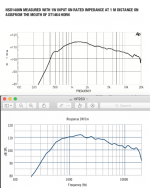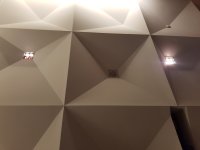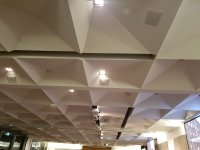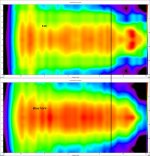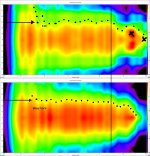I get the points  And yes, makerspaces are slowly appearing around here (only one with serious woodworking ability for the whole of Brussels though). Still:
And yes, makerspaces are slowly appearing around here (only one with serious woodworking ability for the whole of Brussels though). Still:
- The k-horn is huge (50*50*50cm) ! It's particularly deep compared to more traditional horns (the ebay one is 45*25*20cm).
- For a possible first attempt with a horn speaker, I'd rather keep the price contained. That makes the ebay horn above quite attractive.
Another possibility is to simply build this summer a pair of speakers based on the fane 12-250tc full range and later add a pair of horns on top.
- The k-horn is huge (50*50*50cm) ! It's particularly deep compared to more traditional horns (the ebay one is 45*25*20cm).
- For a possible first attempt with a horn speaker, I'd rather keep the price contained. That makes the ebay horn above quite attractive.
Another possibility is to simply build this summer a pair of speakers based on the fane 12-250tc full range and later add a pair of horns on top.

If you compare 2 suitable drivers on the same horn, and both are equalised flat, there should be no difference in sound.
I disagree with this statement. First of all, different magnet materials will sound different. There is a reason alnico is prized. Ferrite and Neo have different inductance's than each other, and will behave differently as the power band changes. Secondly, there is a lot more to sound than frequency response. Harmonics, phase, and phase plugs will all have an effect on the sound.
Then there is the fact that one of the drivers mentioned has two motors. The HF will have better stopping and stopping ability on the dual motor driver, because it is lighter, and will have a better chance at reproducing the highs, then the mids will have an advantage over the other 4" VC drivers, even though it has a 3.5" VC, it has a larger surface area diaphragm.
edit: Then there are really esoteric differences, like how the diaphragm is behaving under load, and the pattern that it's output exhibits in the horn.
Yea, and the driver is certainly specified for a 500Hz cross, so why not?
Pattern control won't be 'perfect': the 18 Sound XT1464 has a nominally 50 degree pattern, but by 600Hz, that has spread to 100 degrees.
OK, I tried 500Hz and 575 HZ crossover points with XT1464...(as opposed to my usual 650Hz). Both sounded very nice on-axis, very nice.
My concern with going lower than 650Hz with the BMS 4594 has been about diaphragm excursion at max SPL. I've read it may be risky going lower at full SPL.
How do we measure/listen/tell when excursion is getting dangerous? (My only real forte lies in active FIR tuning....past that I'm novice....)
I also have the RCF HF950 horn....supposedly it "loads" down to 400Hz. But I take it loading and pattern control are different phenomenon as the horn has to be too little to control patter down to 400Hz, right?
Would the HF950 be a safer horn to play with lower xovers at high SPL? If so, what part of the horn design makes the HF950 "load" lower than the XT1464?
thx,
mark
I disagree with this statement. First of all, different magnet materials will sound different. There is a reason alnico is prized. Ferrite and Neo have different inductance's than each other, and will behave differently as the power band changes. Secondly, there is a lot more to sound than frequency response. Harmonics, phase, and phase plugs will all have an effect on the sound.
Then there is the fact that one of the drivers mentioned has two motors. The HF will have better stopping and stopping ability on the dual motor driver, because it is lighter, and will have a better chance at reproducing the highs, then the mids will have an advantage over the other 4" VC drivers, even though it has a 3.5" VC, it has a larger surface area diaphragm.
edit: Then there are really esoteric differences, like how the diaphragm is behaving under load, and the pattern that it's output exhibits in the horn.
Hi Jack,
I very much agree with your post.
That said, I have very little experience with compression drivers....two as a matter of fact. The BMS 4594HE and 4593.
I have put both of these on several different horns, and with every horn the result was the same.
The 4593 sounded excellent, but the 4594HE simply sounded a little clearer, more open.
And it was not a matter of different tuning / different equalization.
In every test case, there was near perfect mag and phase response, at least on-axis where I was evaluating.
BTW, do you have any favorite horns for the 1.4"s ?
I'm also thinking about giving the 4592 a try...any 2" recommendations?
And sorry to keep picking your brain, but as in my immediately prior post, I need to learn how to judge safe excursion limits, ...if you have any advice to offer.
thx, mark
Mark,1)OK, I tried 500Hz and 575 HZ crossover points with XT1464...(as opposed to my usual 650Hz). Both sounded very nice on-axis, very nice.
2)My concern with going lower than 650Hz with the BMS 4594 has been about diaphragm excursion at max SPL. I've read it may be risky going lower at full SPL.
How do we measure/listen/tell when excursion is getting dangerous? (My only real forte lies in active FIR tuning....past that I'm novice....)
3)I also have the RCF HF950 horn....supposedly it "loads" down to 400Hz. But I take it loading and pattern control are different phenomenon as the horn has to be too little to control patter down to 400Hz, right?
4)Would the HF950 be a safer horn to play with lower xovers at high SPL? If so, what part of the horn design makes the HF950 "load" lower than the XT1464?
thx,
mark
1)The 18 Sound XT1464 is well behaved to below 500 Hz, rolling off at around 24 dB per octave below.
2) The risk of diaphragm destruction certainly is less with plastic than aluminum, but when any diaphragm hammers on the phase plug it is easily audible. Since the horn magnitude is falling while excursion is rising rapidly, it takes little power for contact to occur. You can safely hear the sound using a sine wave of a few watts at say 200 Hz- the "clacking" will exceed the fundamental tone quite obviously- you won't need measurements to know the exact voltage level needed for an instant change.
3)Yes, loading and pattern control are quite different. The loss of pattern control due to relatively small mouths also results in less forward gain at lower frequencies, so loading becomes almost academic at the 400 Hz "cut-off frequency" of the RCF HF950, more than -12dB from it's mid-band response.
4) If by lower crossover, you mean 500 Hz and up, the 18 Sound XT1464 would actually be better in terms of more output with less excursion. The relatively long "pinched throat" of the RCF HF950 results in a more shallow LF roll off, but the wider dispersion has less horn gain.
The slightly longer and more narrow pattern of the XT1464 results in more output to a lower frequency, with a steeper cut-off below.
Attachments
BTW, do you have any favorite horns for the 1.4"s ?
I'm also thinking about giving the 4592 a try...any 2" recommendations?
And sorry to keep picking your brain, but as in my immediately prior post, I need to learn how to judge safe excursion limits, ...if you have any advice to offer.
thx, mark
Hello Mark,
All of the horns that I use are either outdated, or I made them myself.
Re excursion limits, BMS have two different power ratings, AES and Peak.
AES is thermal, Peak is mechanical.
+ the previous reply.
I have seen or heard of one mid diaphragm shattering, so it is possible, but almost all the failures in BMS are by power/thermal.
Regards, Jack
I disagree with this statement. [...] different magnet materials [...] and will behave differently as the power band changes [...] Then there are really esoteric
Context.
Who is the OP to whom I was responding? The OP is someone who has a 10 watt amp and is building their first horn speaker in a 9' x 9' room. They said:
Honestly some of the information has been pretty daunting
...so while this minutiae might fascinate some people, my suggestion is that the OP can probably live without it.
Hey Guys got some bad news.
I got scammed by the ones selling the Klipsch K510 horns.
I wont go into the details since Im a bit depressed right now about it.
I was such a naive chump (the fact that he wanted a western union transaction and not paypal should have been a red flag :-( but I just got too excited)
Too bad since I already ordered a tweeter horn from fastlane audio and that transaction went sooo smoothly.
Leason learned but an expensive one (dont ask me how much it’s still a pain in the ***)
Thing is he knew all the details needed and about the horns. Made a deposit and haven’t heard from him for two weeks. Searched his info more thoroughly with the help of an IT guy and it seems he is a career scammer with complaints from the polk and other forums.
Anyway beware of this name and email:
Ernest Mays Jr
ernesttrem@gmail.com
626-219-7960
Getting a bit disheartened with this project but i’ll pursue it when funds become available again.
Thank you so much for all the information, it may be daunting but very very informative.
Hollowboy those are really cool links. Appreciate the updates man. Special thanks to Cask05 for his recos.
I got scammed by the ones selling the Klipsch K510 horns.
I wont go into the details since Im a bit depressed right now about it.
I was such a naive chump (the fact that he wanted a western union transaction and not paypal should have been a red flag :-( but I just got too excited)
Too bad since I already ordered a tweeter horn from fastlane audio and that transaction went sooo smoothly.
Leason learned but an expensive one (dont ask me how much it’s still a pain in the ***)
Thing is he knew all the details needed and about the horns. Made a deposit and haven’t heard from him for two weeks. Searched his info more thoroughly with the help of an IT guy and it seems he is a career scammer with complaints from the polk and other forums.
Anyway beware of this name and email:
Ernest Mays Jr
ernesttrem@gmail.com
626-219-7960
Getting a bit disheartened with this project but i’ll pursue it when funds become available again.
Thank you so much for all the information, it may be daunting but very very informative.
Hollowboy those are really cool links. Appreciate the updates man. Special thanks to Cask05 for his recos.
- For a possible first attempt with a horn speaker, I'd rather keep the price contained. That makes the ebay horn above quite attractive.
Good point. Particularly if horns are new territory, I think the low price, robust (accident proof) drivers and very easy eq are strong reasons to go with that combo.
Getting a bit disheartened with this project but i’ll pursue it when funds become available again.
That's bad news, but why wait?
An ebay horn + a 2" wide band driver don't need a lot of funds.
You could get them as something to listen to while you save up for some premium compression drivers. The worst case scenario is that you upgrade to some seriously good compression drivers, and then you'd demote the little 2" drivers to desktop use, or sell them off.
Have you read his corner horn FAQ? It is jammed with good info.Special thanks to Cask05 for his recos.
The first image seems like a good, practical, configuration for a small room - lots of horn mouth, without taking up much floor area.
Corner Horn Imaging FAQ
Hey Guys got some bad news.
I got scammed by the ones selling the Klipsch K510 horns.
That is bad news, but I will say that I was somewhat surprised by the apparent ease with which you had found some. I've been looking, and they are hard to find used.
That said, if you comb the Klipsch forum, you are likely to find at least a couple of sources, from professional, and authorized, sellers.
The first image seems like a good, practical, configuration for a small room - lots of horn mouth, without taking up much floor area...Corner Horn Imaging FAQ
You're one of the very few that have recognized and mentioned this capability. I believe that a lot of people fail to see that:
1) loudspeakers that are high performing are usually quite large, and
2) floor space (i.e., loudspeaker effective depth including spacing from wall, if any) is a big deal--a much bigger deal than the size of their horn mouths.
Their horn mouths can be covered in grill cloth if you don't like looking at horns, and effectively be much smaller in terms of total room volume demands.2) floor space (i.e., loudspeaker effective depth including spacing from wall, if any) is a big deal--a much bigger deal than the size of their horn mouths.
By the way, a link to the polar sonograms of the horn that I believe you mentioned above: Heritage Klipsch - that big "theater" sound and "HOM" ? - Technical/Modifications - The Klipsch Audio Community
And a link to the polar sonograms of the K-510 horn: PA speakers for home use - Page 4 - Home Theater - The Klipsch Audio Community
Note that the polar sonograms aren't the only part of the story that's important. Having straight-sided horn walls near the throat (like the K-510 and K-402 have) also affects their subjective sound quality quite strongly.
Chris
Yea. I remember seeing pix of the (large and visually powerful) Jadis Eurithmie, years ago, and thinking that, if placed in room corners, it would actually be more space efficient than a polite little stand-mounted speaker.floor space (i.e., loudspeaker effective depth including spacing from wall, if any) is a big deal--a much bigger deal than the size of their horn mouths.
Earlier this week, I took some photos of an acoustic ceiling (attached), thinking that a soffit mounted horn could be made in this style:
- visually mild
- off the floor
I just looked Jadis up again, to discover that's almost exactly what the designer's home system looks like.
BIG ol' horns! | Stereophile.com
Something built along those lines, if tilted to fit into the intersection between walls and ceiling, could be rather large, yet take up zero floor space.
Attachments
Anything above 7-8 kHz is controlled by the compression driver phase plug. I thought that was "common knowledge"...Perhaps it isn't.
By the way, a link to the polar sonograms of the horn that I believe you mentioned above
The measurements linked use the same K-69-A driver driver, and should measure the same above 7-8kHz. Do you know why your plots look different above 7-8kHz (was it different amounts of HF boost)?
The description in the link:
"a very good horn that's also very inexpensive and that tests very well in terms of its polars relative to the K-510"
...is a reversal of what you said about that horn in April, e.g.
I'd use it only if lowest price is the requirement...
The smaller horn is the K-510, which has much better performance in terms of polar control
I'm glad to see this reversal.
- having measurements that confirm a cheap option being similar to the expensive / unobtanium option is a win for budget DIY.
- that you are willing to flip your opinion based on the data says good things about your intellectual rigour.
Except that I have heard this horn (the inexpensive one) against the K-510. I'd still choose the K-510. There is a subjective listening difference after EQing flat and using the same driver, etc. The polars that I measured don't show you all the differences.
I suspect it's related to curved side walls near the throat vs. straight walls, and perhaps the mouth flares that are subtly different (although they both appear to have tractrix or truncated tractrix profiles).
Chris
I suspect it's related to curved side walls near the throat vs. straight walls, and perhaps the mouth flares that are subtly different (although they both appear to have tractrix or truncated tractrix profiles).
Chris
There is a subjective listening difference after EQing flat and using the same driver, etc.
That was the question you skipped over.
The plots you have linked do not appear to have had the same EQ.
You said yourself that the horn does nothing over 7-8kHz, so everything to the right of the line should have been exactly the same.
The much hotter & more extended HF on one plot could easily explain your subjective preference for that setup.
Attachments
Perhaps this is a good time for discussing the limitations of polar sonograms and in-room measurements. First, I'll give you the bottom line: the data above 8 kHz is essentially the same for both plots.You said yourself that the horn does nothing over 7-8kHz, so everything to the right of the line should have been exactly the same.
But the color representations are different based on the setting of the "zero dB" for each plot. I chose these plots (EQ as flat as practical, with slight undulations--which are visible across the polar sections) based on the visibility of their details. OmniMic doesn't provide the capability of choosing a zero offset in the polar plot color scale so that you can attempt to show relative increases in SPL at small offset angles in the band 5-14 kHz.
I don't believe that adding that capability (zero dB offset to the color scale) to OmniMic is going to solve the problem of showing the relative increases in SPL off-axis in the polar sonogram plots. I ran normalized data through OmniMic, but the results actually got worse (to my eyes) than to show the raw data, EQed as flat as possible. It's also a lot more "real world" in that normalized plot data isn't really representative of what you're actually going to achieve from the horn/compression driver combination.
With both horns, the places where these local increases of SPL (relative to on-axis) at 10-20 degrees offset is a little different, but essentially within measurement accuracy in-room. (I also see a lot of polar sonograms that have been smoothed too much, thus hiding the local maxima in SPL near the zero-degree on-axis measurement.)
Here's how I read at these polar sonograms:
1) I look at the color associated with the zero-degree (on-axis) measurements, then I go to the right-hand color scale to find what relative dB level that corresponds to.
2) Then I move down the color scale by 6 dB and read the "coverage angle" envelope from that color contour.
3) I look around the -6 dB contour for relative changes in steepness of the color changes with off-axis angle to see how the horn/driver behave, and make a mental note of how that contour changes with frequency.
4) If I look at another polar sonogram of another horn or driver, I make mental notes of the approximate coverage angles and how they change by reading the off-axis angles first, then the relative gradients in color.
Note that the color plots are engaging to look at, but I find that it is easy to misread what you've actually got and try to read more detail than what is actually there. Trying to read increments of 1 dB color changes just isn't within the measurement accuracy of taking these measurements in room. You need an anechoic chamber for that, and I doubt that you're going to see anything worthwhile. YMMV.
Chris
I think I understand you: the 510 plot is cooler on axis, therefore -6dB relative to the axis is also a slightly cooler colour*.
The attached image shows the plots again, this time with my guesstimate of the -6dB contour scribbled on. The coverage angles (marked with arrows) are similar. As expected, the horn with the size advantage keeps control to a slightly lower frequency. The overall shape of the HF spread is similar; both plots show a similar narrowing at ~9kHz, then a widening at 12-13kHz, so I understand why you said this:
However, what about the bits that I marked X?
The 510 plot is quieter / cooler on-axis < 7kHz, yet these marked spots bits are much hotter than on the other graph. Doesn't that mean the 510 was set up in such a way that you had more HF above 10kHz? Assuming your hearing extends >10kHz, wouldn't these hot spots skew a subjective comparison?
---
My own interest is general (I like bargains) and specific: I'm giving up my workshop / studio, but moving to a bigger home. I'll have a room with appropriate corners for horns. I'm thinking of reconfiguring my current "long throw" workshop horns for high efficiency / narrow band use in my outdoor (bush) system, and setting up some lower efficiency, "short throw", wide band horns for home (corner?) use.
If I do that, my practical options are either to start with an easily available off the shelf horn, or to build it from scratch (i.e. another Synergy clone, or something like this):
Klipsch K402 replica build - DIY Audio Projects - StereoNET
Getting a Klipsch horn into Australia is not practical.
*like comparing two PET scans with different SUV settings.
The attached image shows the plots again, this time with my guesstimate of the -6dB contour scribbled on. The coverage angles (marked with arrows) are similar. As expected, the horn with the size advantage keeps control to a slightly lower frequency. The overall shape of the HF spread is similar; both plots show a similar narrowing at ~9kHz, then a widening at 12-13kHz, so I understand why you said this:
First, I'll give you the bottom line: the data above 8 kHz is essentially the same for both plots.
However, what about the bits that I marked X?
The 510 plot is quieter / cooler on-axis < 7kHz, yet these marked spots bits are much hotter than on the other graph. Doesn't that mean the 510 was set up in such a way that you had more HF above 10kHz? Assuming your hearing extends >10kHz, wouldn't these hot spots skew a subjective comparison?
---
My own interest is general (I like bargains) and specific: I'm giving up my workshop / studio, but moving to a bigger home. I'll have a room with appropriate corners for horns. I'm thinking of reconfiguring my current "long throw" workshop horns for high efficiency / narrow band use in my outdoor (bush) system, and setting up some lower efficiency, "short throw", wide band horns for home (corner?) use.
If I do that, my practical options are either to start with an easily available off the shelf horn, or to build it from scratch (i.e. another Synergy clone, or something like this):
Klipsch K402 replica build - DIY Audio Projects - StereoNET
Getting a Klipsch horn into Australia is not practical.
*like comparing two PET scans with different SUV settings.
Attachments
I think you made an assumption that I listened to both horns using the EQ found in the polar plots, above. I've actually listened to both horns over an extended time period using a variety of EQ configurations in each case. There is something other than EQ which is audible. I attribute it to the exact horn profiles.However, what about the bits that I marked X? The 510 plot is quieter / cooler on-axis < 7kHz, yet these marked spots bits are much hotter than on the other graph. Doesn't that mean the 510 was set up in such a way that you had more HF above 10kHz? Assuming your hearing extends >10kHz, wouldn't these hot spots skew a subjective comparison?
The differences that you think that you're reading on the plots are probably more attributable to measurements in-room than actual differences in polars--as measurable in a chamber (as I mentioned above).
Chris
- Home
- Loudspeakers
- Multi-Way
- Smallest Footprint Horn and Driver that can reach 500 Hz
